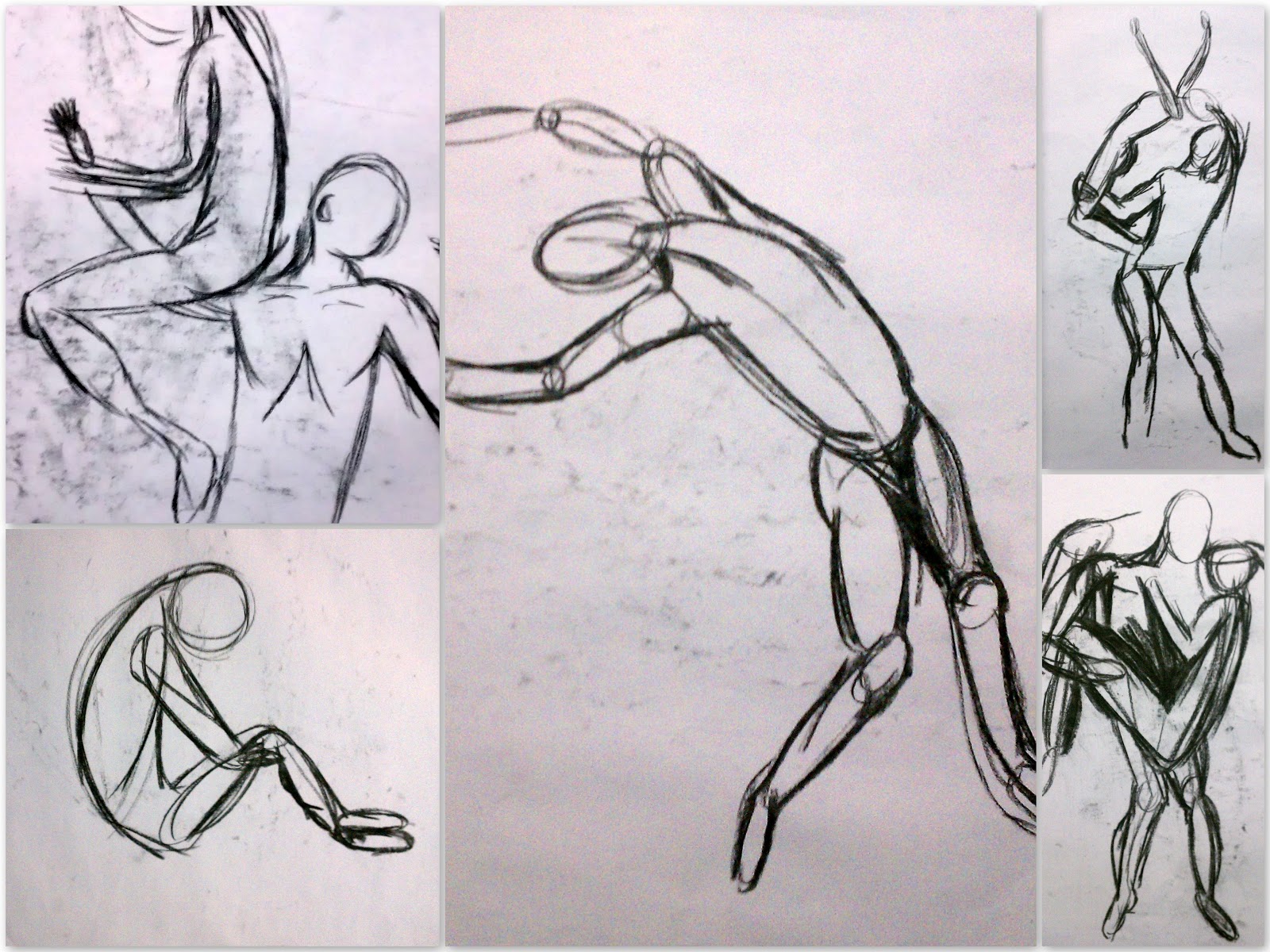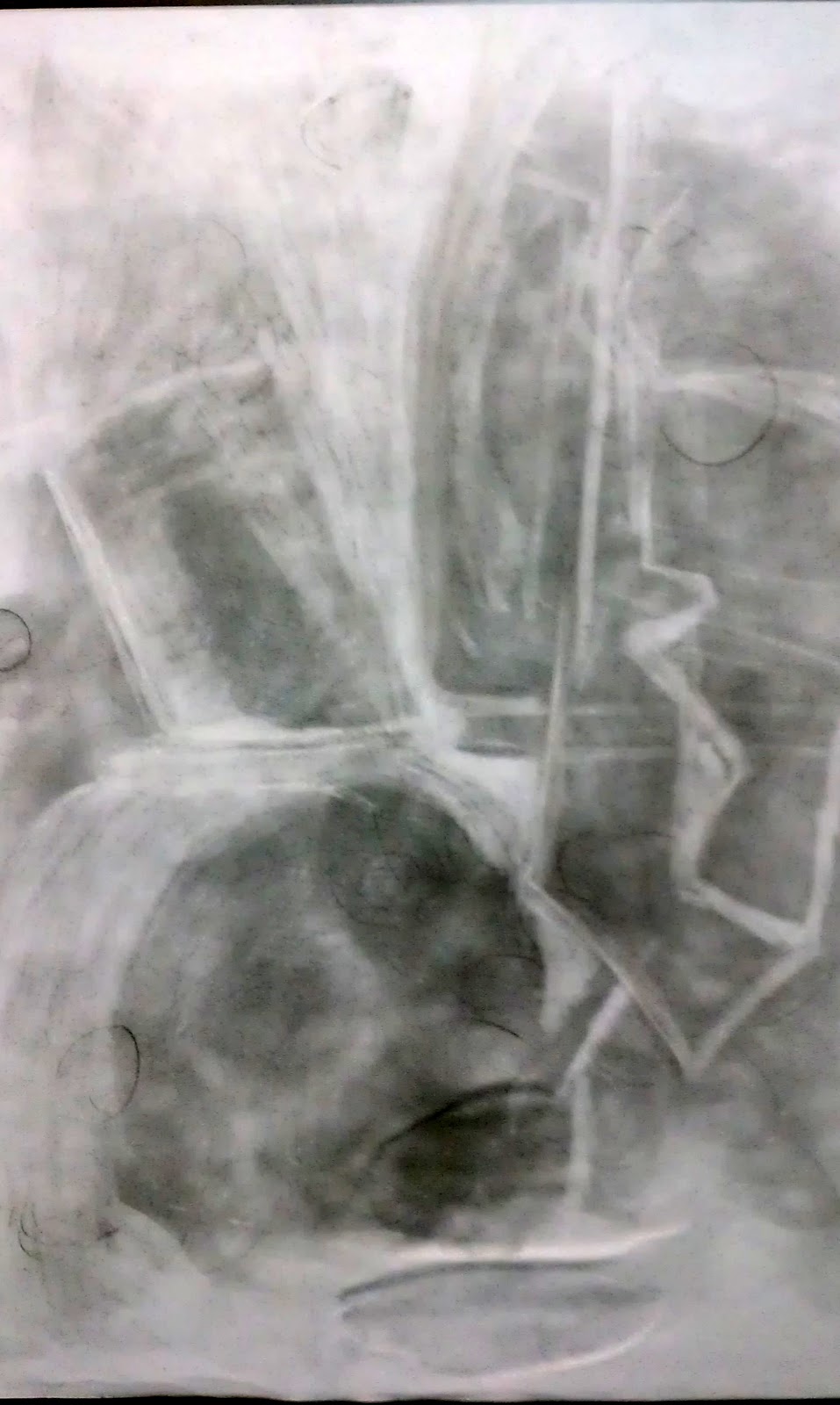 During this assignment, we were to take the defined lines and drawings which we had been doing and loosen up. During the gesture drawings, we began with drawing a general line to the form of the body or figure. Then in using bubbles and circles we could begin to see the form take shape, and movement. As we progressed, we could begin cutting out the line and the bubbles and just focus on using "wire" lines in the drawing. The lines were to give movement to the subject on the paper. This simple lesson has made me more confident in drawing figures now. Using this gesture drawing technique, it is easier to see the form of a figure.
During this assignment, we were to take the defined lines and drawings which we had been doing and loosen up. During the gesture drawings, we began with drawing a general line to the form of the body or figure. Then in using bubbles and circles we could begin to see the form take shape, and movement. As we progressed, we could begin cutting out the line and the bubbles and just focus on using "wire" lines in the drawing. The lines were to give movement to the subject on the paper. This simple lesson has made me more confident in drawing figures now. Using this gesture drawing technique, it is easier to see the form of a figure.
Sunday, 14 October 2012
Gesture Drawing
 During this assignment, we were to take the defined lines and drawings which we had been doing and loosen up. During the gesture drawings, we began with drawing a general line to the form of the body or figure. Then in using bubbles and circles we could begin to see the form take shape, and movement. As we progressed, we could begin cutting out the line and the bubbles and just focus on using "wire" lines in the drawing. The lines were to give movement to the subject on the paper. This simple lesson has made me more confident in drawing figures now. Using this gesture drawing technique, it is easier to see the form of a figure.
During this assignment, we were to take the defined lines and drawings which we had been doing and loosen up. During the gesture drawings, we began with drawing a general line to the form of the body or figure. Then in using bubbles and circles we could begin to see the form take shape, and movement. As we progressed, we could begin cutting out the line and the bubbles and just focus on using "wire" lines in the drawing. The lines were to give movement to the subject on the paper. This simple lesson has made me more confident in drawing figures now. Using this gesture drawing technique, it is easier to see the form of a figure.
Neutral Ground Figures
Once I began this assignment, I actually became more comfortable then I was in the last Light Value drawing we did. I began to understand better how using the eraser, you slowly begin to "paint away" the darkness to form the subject which we were to "draw." Once I was able to do the subjects I was able to go in and with my pencil add crosshatching and to darken the negative spaces and in the contour of the bodies. Also the use of the white chalk helped me to define the bodies a bit more. My work shows a big difference in values, from white to dark black.
Neutral Still life
 During this assignment I found that wrapping my mind around the concept was difficult for me. We were to use a middle value ground and in using our eraser, draw out what we saw in the still life. The concept behind this lesson was learning how to take a neutral space and change the value to form works of art. We were able to practice value differentiation and how to change the value in certain areas. The eraser would make the shade lighter while the use of our pencil could make the negative space and shadows darker. I did not really grasp the idea till we got to our second assignment which is very close to this one. What I did like was learning how to take a darker background and using it to draw in lighter objects. Also, using the chalk allows you to add extra contour to the drawing itself and to help with the shape of the objects against the light source.
During this assignment I found that wrapping my mind around the concept was difficult for me. We were to use a middle value ground and in using our eraser, draw out what we saw in the still life. The concept behind this lesson was learning how to take a neutral space and change the value to form works of art. We were able to practice value differentiation and how to change the value in certain areas. The eraser would make the shade lighter while the use of our pencil could make the negative space and shadows darker. I did not really grasp the idea till we got to our second assignment which is very close to this one. What I did like was learning how to take a darker background and using it to draw in lighter objects. Also, using the chalk allows you to add extra contour to the drawing itself and to help with the shape of the objects against the light source.
Interior Contour
In art, there are three types of lines which may be used. There is Actual lines which are as they seem, are present in the drawing. An actual line may be curvy or straight, thick or thin. Implied lines are usually formed or represented with dots or dashes (- - - - / . . . . . . . . . ). Even though the dots or dashes may not touch, they "imply" there there should be a line there. And the third line is one used every day, is the psychic line. When we are looking at anything there is a psychic line connected from our eyes and what we are looking at. When we want to show someone something, we may point at the object, which is another form of a psychic line.
My drawing consists mostly of thick and thin actual lines. There are some places where the lines are not continuous so they could be considered an implied line. When I wanted to make an area of the drawing flow differently the lines would go in a different direction. When I wanted an area to be darker in value, I would use heavy lines or more lines. I used some crosshatching for darker shadow areas, and tried to stay with the actual original flow of the lines which were cast upon the still life in class.
Sunday, 7 October 2012
Abraham Lincoln in Chalk
I was rather intimidated by this assignment. To begin with I
was absent the day the assignment was explained, and the whole idea of using
the chalk freely was definitely going to be a different turn for me. I must say
my worries were way wrong. As soon as I began rubbing the white chalk against
the black paper, I automatically began to form out the drawing section by
section. As I was drawing, I would look at the picture, and try to imagine his
face. Imagine the contour and shadowing which happens when you work with the
relationship between the chalk and paper. . In order to show the value
difference in this piece, all you had to work with was the lightness of the
chalk and the darkness of the black paper background. By rubbing the chalk hard
or more often on a place, the value keeps getting lighter and lighter. By using the blunt end of the chalk only, I
was able to complete a work which showed lines, values, shadows, and details.
Subscribe to:
Comments (Atom)


